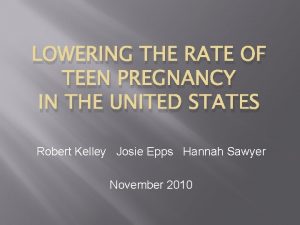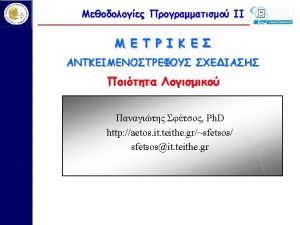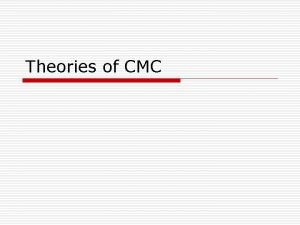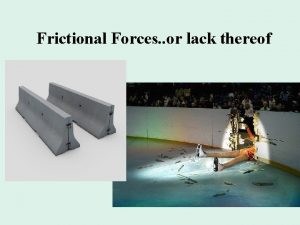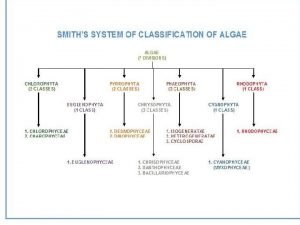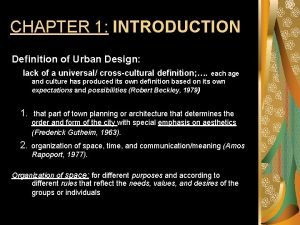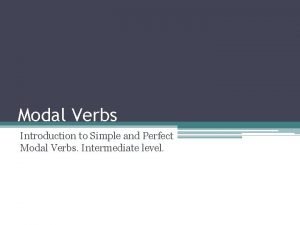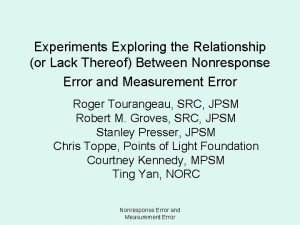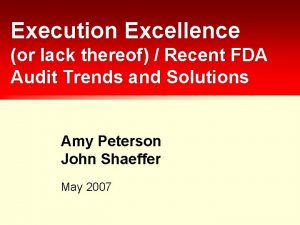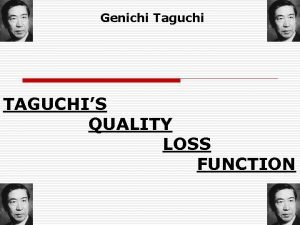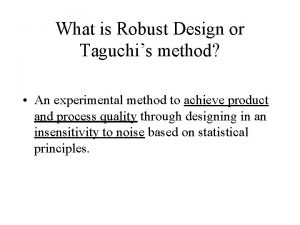Taguchis Definition of Quality or lack thereof The













































































- Slides: 77


Taguchi’s Definition of Quality –or lack thereof “ The loss a product causes society after it is shipped ” Loss due to 1) Variability in function 2) Harmful side effects

Noise –Sources of Functional Variation (1) Inner or deterioration noise (2) Outer or environmental noise (3) Variational or piece to piece variation caused during manufacture

Examples Refrigerator temperature control inner noise – leakage & mechanical wear of compressor parts outer noise – use conditions, frequency of opening, what stored, ambient temp. , voltage variation etc. variational noise – tightness of door, amount of refrigerant, imperfection in compressor parts etc. Automobile Brakes inner noise – wear of drums and pads, leakage of fluid outer noise – road conditions, speed of car, weight etc. variational noise – fits, variation in friction coefficient etc.

Controllable input factors Input Process Uncontrollable input factors Output y

Activities Where Counter Measures to Noise are Possible Activity/Noise Source Inner Noise Outer Noise Variational Noise Manufacturing X X O Process Design X X O Product Design O O O X – No Countermeasure Possible O – Countermeasure Possible

Robust Parameter Design Experiments




Simulated Noise factor H represents position in the kiln - = in the center, + = near kiln walls where temperature is higher Total of 27 -4 = 8× 21 = 16 measurements


Total of 9× 8=72 tests

Output RT resistance at which the relay turns on

Levels for noise factors ± 2. 04% of nominal setting Example: when control factor A is 2. 67 low level of noise factor A is (1. 0 -0. 0204)× 2. 67=2. 62 high level of noise factor A is (1. 0+0. 0204) )× 2. 67=2. 72


Noise Factor Array when =



H = - (inner kiln position), H = + (outer kiln position) response = number of defective per 100 tiles



Effects on the mean Positive Effect


Effects on the loge(var) Positive Effect


Conclusion: increasing the content of lime from 1% to 5% reduces the average percentage of defective tiles, and reduces the variability in percentage of defective tiles caused by the temperature gradient in the kiln.










Data written in a single array format Run A B C D E -1 -1 1 1 F G H y 1 -1 2 1 3 -1 4 1 5 -1 -1 1 6 1 -1 7 -1 1 1 -1 -1 0. 433 8 1 1 1 9 -1 -1 -1 1 0. 489 10 1 1 0. 422 11 -1 1 1 0. 201 12 1 1 -1 -1 -1 1 0. 284 13 -1 -1 1 1 0. 833 14 1 -1 -1 1 1. 571 15 -1 1 1 -1 -1 1 0. 927 16 1 1 1. 571 -1 -1 1 1 -1 0. 171 1 -1 0. 120 1 -1 -1 0. 060 1 -1 -1 1 1 -1 0. 212 1 -1 -1 -1 0. 748 -1 -1 -1 0. 161 1 1 -1 0. 263 1

No replicates of whole plots, therefore analysis is conducted by making separate normal plots of whole-plot effects and sub-plot effects as described in Sections 8. 4 and 8. 5.






Response Modeling with Multiple Noise Factors


Standardize orthogonal contrasts by dividing by the square root of the Number of replicates of each level of the factor in the design. This makes the (X 'X) a 72× 72 Identity matrix



Fit a model to the largest effects identified on the normal plot

Interpretation of Results




(33× 2)=2

1/6 fraction





Adjustment Factor

Single Array Experiment to Improve an Injection Molding Process Excessive part shrinkage was causing assembly problems Control Factors (could be easily varied): A: mold temperature B: screw speed C: holding time D: gate size Noise Factors (normally difficult to control): E: cycle time F: moisture content G: holding pressure



Shrinkage is minimized when mold temperature is at the low level, there are no significant control by noise interactions to exploit.

Too much variability in % Shrinkage at low screw speed. This will still cause problems in assembly.

Box plots show C: holding time is a dispersion effect. Choosing the low level of holding time reduces variability in % shrinkage.











 Management gurus and their contributions
Management gurus and their contributions Quality control and quality assurance
Quality control and quality assurance Pmp quality vs grade
Pmp quality vs grade Pmbok quality management
Pmbok quality management Process of nursing audit
Process of nursing audit Quality improvement vs quality assurance
Quality improvement vs quality assurance Basic quality concepts
Basic quality concepts Crosby's fourteen steps to quality improvement
Crosby's fourteen steps to quality improvement Old quality vs new quality
Old quality vs new quality Modal verb obligation
Modal verb obligation Lack of communication between parents and teenager
Lack of communication between parents and teenager Prqrt
Prqrt A lack of voluntary consent:
A lack of voluntary consent: Reuptake of neurotransmitters
Reuptake of neurotransmitters Lack of diversification
Lack of diversification Roxanne borja sex
Roxanne borja sex Fat overconsumption
Fat overconsumption Causes of teenage pregnancy
Causes of teenage pregnancy Lack of unity example
Lack of unity example Lack of cohesion of methods
Lack of cohesion of methods Your child's success or lack of success
Your child's success or lack of success Lack of knowledge in teenage pregnancy
Lack of knowledge in teenage pregnancy Your child's success or lack of success
Your child's success or lack of success Assuage sentence
Assuage sentence Approaches to user support
Approaches to user support Cuelessness model
Cuelessness model Psalm 23 john piper
Psalm 23 john piper Users over lack support
Users over lack support Friction force definition
Friction force definition Criminal addictive thinking
Criminal addictive thinking Which one is barrier to speaking
Which one is barrier to speaking Used so often as to lack freshness or originality
Used so often as to lack freshness or originality Lack of commitment in church
Lack of commitment in church Trichomes of blue green algae lack
Trichomes of blue green algae lack O/o medical term
O/o medical term Reportive definition
Reportive definition Lack meaning
Lack meaning Mannering
Mannering Communication style meaning
Communication style meaning Lack meaning
Lack meaning Foliage giving shade
Foliage giving shade Golden opulence sundae
Golden opulence sundae Lyric poetry haiku
Lyric poetry haiku Living together video
Living together video Effects of lack of sex in marriage
Effects of lack of sex in marriage Lack of presentation skills
Lack of presentation skills Lack of necessity
Lack of necessity Which of the following explains this phenomenon?
Which of the following explains this phenomenon? Dramatic poetry examples
Dramatic poetry examples Prokaryotic cells lack
Prokaryotic cells lack Hát kết hợp bộ gõ cơ thể
Hát kết hợp bộ gõ cơ thể Lp html
Lp html Bổ thể
Bổ thể Tỉ lệ cơ thể trẻ em
Tỉ lệ cơ thể trẻ em Chó sói
Chó sói Glasgow thang điểm
Glasgow thang điểm Bài hát chúa yêu trần thế alleluia
Bài hát chúa yêu trần thế alleluia Các môn thể thao bắt đầu bằng tiếng đua
Các môn thể thao bắt đầu bằng tiếng đua Thế nào là hệ số cao nhất
Thế nào là hệ số cao nhất Các châu lục và đại dương trên thế giới
Các châu lục và đại dương trên thế giới Công thức tiính động năng
Công thức tiính động năng Trời xanh đây là của chúng ta thể thơ
Trời xanh đây là của chúng ta thể thơ Mật thư anh em như thể tay chân
Mật thư anh em như thể tay chân Phép trừ bù
Phép trừ bù độ dài liên kết
độ dài liên kết Các châu lục và đại dương trên thế giới
Các châu lục và đại dương trên thế giới Thơ thất ngôn tứ tuyệt đường luật
Thơ thất ngôn tứ tuyệt đường luật Quá trình desamine hóa có thể tạo ra
Quá trình desamine hóa có thể tạo ra Một số thể thơ truyền thống
Một số thể thơ truyền thống Bàn tay mà dây bẩn
Bàn tay mà dây bẩn Vẽ hình chiếu vuông góc của vật thể sau
Vẽ hình chiếu vuông góc của vật thể sau Biện pháp chống mỏi cơ
Biện pháp chống mỏi cơ đặc điểm cơ thể của người tối cổ
đặc điểm cơ thể của người tối cổ V cc cc
V cc cc Vẽ hình chiếu đứng bằng cạnh của vật thể
Vẽ hình chiếu đứng bằng cạnh của vật thể Vẽ hình chiếu vuông góc của vật thể sau
Vẽ hình chiếu vuông góc của vật thể sau Thẻ vin
Thẻ vin đại từ thay thế
đại từ thay thế

















